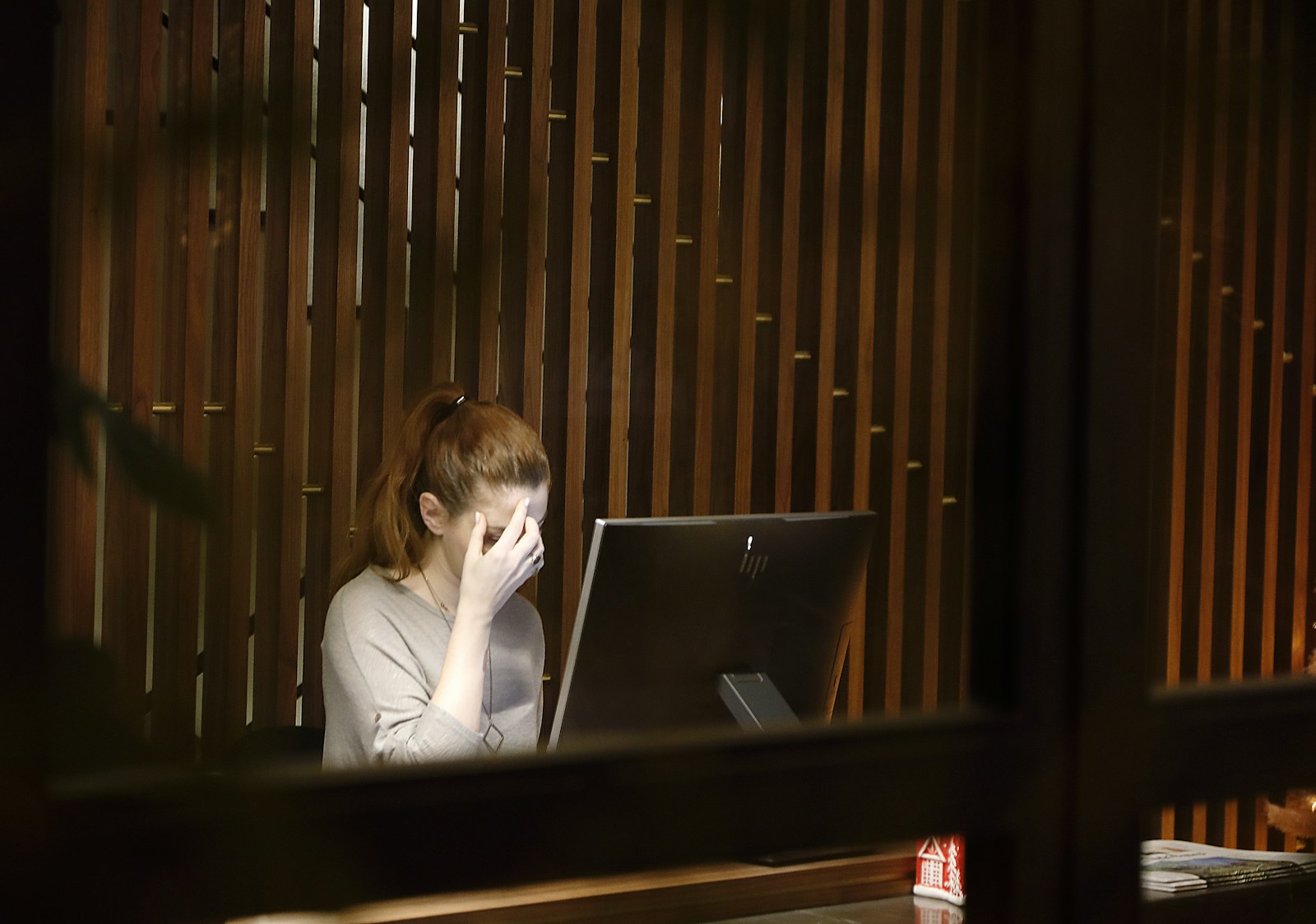Coaches can help organizations reverse the human sustainability crisis
Despite increased investment in employee wellness programs, stress, burnout, and turnover remain high. Coaches can help organizations uncover and address the root causes of the human sustainability crisis.
Challenge:
Employee wellness programs that treat the symptoms of poor well-being often fail to address employee stress and turnover
Opportunity:
Coaches can help organizations identify the systems and cultures that contribute to poor workforce well-being
Impact:
Organizations that address the root causes of employee stress will be able to reimagine work in a way that supports employee thriving
Wisdom Weavers
Overcoming challenges in workplace well-being starts with understanding human sustainability
The world of work is in a state of human crisis and transformation. Prolonged poor employee well-being trends have led to increased stress, with over half of workers looking for new employment. Studies indicate that 40% of workers still feel exhausted, 22% experience negative emotions, and 22% report experiencing burnout. Despite a 51 billion-dollar wellness industry, the effectiveness of these programs has yet to be realized. A recent report by the University of Oxford Wellbeing Research Centre reveals that wellness programs are often ineffective because they only address the symptoms of poor workplace well-being.
Urgent action is required, or organizations risk losing top talent to those organizations embracing systemic change. Speaking on the talent shortage in Western Europe, Wisdom Weaver Réka Deàk argues, “When we look at the trends shaping the future of well-being, there is the matter of how much or how deeply a company is willing to invest in change. When there is a big gap between one company and another, that is one reason for people who are not getting their needs met to move on.”
From declining to thriving
Coaches can help organizations uncover the root causes of poor employee well-being and guide workplace transformation to support human sustainability. Once identified, coaches can empower organizations, teams, and individuals to find solutions that foster a thriving environment. One of the major challenges highlighted by research is the prevalence of overwhelm in the workplace. Overwhelm, as a state of constant stress, is a product of one or more workplace challenges where employees no longer have the resources to meet work demands. Coaches can help leaders examine the root causes of overwhelm and guide solutions for managing information overload, prioritizing recovery, and balancing energy.
Information overload: Finding time to disconnect and reconnect
In 2020, average screen time for U.S. workers rose to over thirteen hours per day. Beyond the physical impact of increased screen time, employees are also struggling with the psychological impact of technology overuse. A systematic review of technology overload in the workplace indicates that challenges like constant emails, multi-tasking, and frequent interruptions all contribute to greater employee stress. Not only do these challenges hinder employee productivity on the job, but they also contribute to social burnout and family conflict outside of work. Wisdom Weaver Amy Blankson explains it is not just the amount of information, but the number of channels employees monitor, from email to instant messengers and personal accounts. Offering a solution, Amy suggests that “In the future, technology can help us aggregate those communication channels and invite more strategies to create a frictionless work and life experience.”
Instead of waiting for new technology to solve information overload, Wisdom Weaver and digital well-being speaker Anastasia Dedyukhina encourages organizations to consider administrative, structural, and cultural solutions. She proposes that organizations create formal positions to support digital well-being or equip informal digital well-being champions to lead these solutions. “Every organization should have a Chief Digital Well-being Officer.” Without digital well-being experts, Anastasia asks, “Who will work to understand legislation around privacy, and the impact of digital stress on our ability to learn in social interactions, manage attention, and maintain performance? Who would advise on new technologies before implementation and monitor and coordinate technological advances as they are rolled out?”
The issue of constant connection extends beyond the workplace and goes into personal time. Coaches can lead change in this area by prompting leaders to consider how to honor digital communication boundaries and support healthy disconnect from work in a flexible environment. On an individual level, Amy champions coaching as a powerful resource to help professionals define and advocate for digital boundaries: “Coaches can be crucial in helping individuals to navigate living in a world where people are expected to be responsive 24/7. What does that look like as a human being? Is it even sustainable? What kind of power do we have to change the future, and what do we want it to look like?” Structural and administrative solutions will become increasingly important as policymakers look to ban out-of-office communication to support the right to disconnect.
Human sustainability requires awareness and skills-building for rest and recovery
Deloitte’s 2023 Well-Being at Work survey indicates 75% of respondents struggle to take time off work. Beyond delaying vacations or skipping breaks, workforce surveys estimate that between 75-81% of workers check their emails after work hours. Even when taking breaks and avoiding after-hour emails, employees can still struggle to disconnect from work-related stress. Réka believes that “well-being is both a future skill and a leadership skill.” Borrowing wellness practices from other high-performance contexts, Réka highlights that professional athletes work to develop well-being skills that support mental and physical fitness. When coaching in organizations, she uses the Corporate Athlete example to highlight the benefit of both rest and recovery, “Athletes have a season to compete, but afterward, they take care of their well-being in terms of recharging. We rarely do this in the corporate world. Of course, we have holidays, but not everyone can use them, or they may not have the self-awareness to use them in a way that brings back energy.”
Beyond promoting vacation or time off, coaches can help clients evaluate what activities, practices, and relationships help them use rest time to recharge their physical, emotional, and social batteries. Reflecting on the increases in both work and screen time during the pandemic, Amy shares that many workplaces are struggling to move forward in their wellness programs because they are applying old assumptions to new flexible work structures. The rise of flexible work opportunities means that constant connection will continue to be a well-being challenge; however, Réka pushes back on the idea that flexible work is causing these challenges. She argues that instead of blaming hybrid work for well-being problems, “flexible work presents new opportunities for leaders to change things and create environments that support the well-being of all workers. We cannot go back to the old ways of working.” Gallup’s research strengthens this conclusion, noting that although remote workers are more likely to be stressed, they are also more likely to be engaged at work, followed by those with hybrid positions.
Balancing workload to respect natural cycles in human energy
Expectations that humans always perform at peak capacity during the workday perpetuates the issue of overwhelm. When employees face constant tight deadlines and juggle multiple large projects, they may not have the capacity to balance their energy between tasks or maintain focus through the entire day. Another challenge, multi-tasking, increases stress because the human brain cannot fully focus on two competing tasks, but instead quickly switch between tasks, leading to fatigue. Anastasia connects these workplace stressors to the common metaphor of the workplace as a “machine.” Unlike humans, machines can multi-task, go without rest, and maintain the same level of performance over an extended period of time. Because organizations are made of people, she argues that expecting them to be productive for eight consecutive hours is unrealistic. To maximize human capital, organizations will need to rethink the relationship between employees and work, creating systems that honor natural cycles in human energy, attention, and creativity.
When employees are given appropriate workloads, flexibility, and the autonomy to design their workflow, they are empowered to structure work activities around natural ebbs and flows in human energy. In her work as an organizational wellness coach, Réka helps clients understand that “To truly create a well-being culture means integrating well-being into every level of the organization. People in a well-being culture are highly engaged to drive high team performance and also reach business goals. At the same time, they have a sustainable work life where they can pursue individual purpose and make the most of free time.” To create these environments, Réka sees more and more organizations adopting “well-being workflows.” “Today, the European job market is full of change managers, and it is not a question of if a company has a change manager. I see this as a prediction for workplace well-being in the future.”
Human sustainability requires a shift in coaching practice to support holistic well-being over a system of overwork and burnout. To highlight the relationship between rest, recovery, and work, Réka has clients forecast into the future, “Sustainable performance is more forward-looking than high performance. So, in coaching, I work with clients to understand how they can be a sustainable performer. After that, we come together in a team coaching setup to ask how we can internalize what it takes for each one of us to be well. Ultimately, we work together to define some principles on how we would like to operate as a team. That does not mean that now we need people to give up for themselves for the team. It is more about understanding each other and respecting the differences.”
A Call to Action for Coaches
Prioritizing human sustainability as a coach requires a shift to honor the full scope of holistic well-being. Grounding this approach in ethics of care, coaches have a responsibility to advocate for client well-being separate from goals surrounding performance and productivity. This work includes rejecting approaches that add wellness initiatives to an unwell system and seeking the mandate to help organizations and teams create systems that enable well-being.
Coaches can approach this work in a way that honors client autonomy by building trust and applying open questioning to understand values around work and well-being. This process can help coaches highlight contradictions between workplace culture, practices, goals, and employee experience. Coaches can then partner with clients to identify ways to integrate systems that support a more human workplace.
Transformational questions:
- How can coaches help organizations uncover root causes of overwhelm and burnout?
- What is the role of coaches in championing cultures and practices that support human sustainability?
- Thinking of well-being as a future skill, how can coaches support skills development in personal and collective well-being?
- How do coaching conversations reveal the difference between rest and recovery?
Dive into more research on human sustainability and the future of workplace well-being:
- Listen to podcasts like the WorkWell podcast or Wellbeing Designers to learn more about creating a culture of wellness at work
- Learn more about Well-Being Intelligence as a futures skill from researchers in behavioral health and organizational management
- Explore continued education opportunities like the ICF-accredited training in digital wellness through Consciously Digital
- Dig into research from Deloitte’s series on Global Trends in Human Capital and human sustainability
- Learn more about Digital Flourishing and what it means to be a Digitally Balanced Workplace through the Digital Wellness Institute
- Consider using this short resource from the World Health Organization to map out contextual sources of workplace stress
- Look back at resources from ICF Thought Leadership on the relationship between purpose and employee engagement







